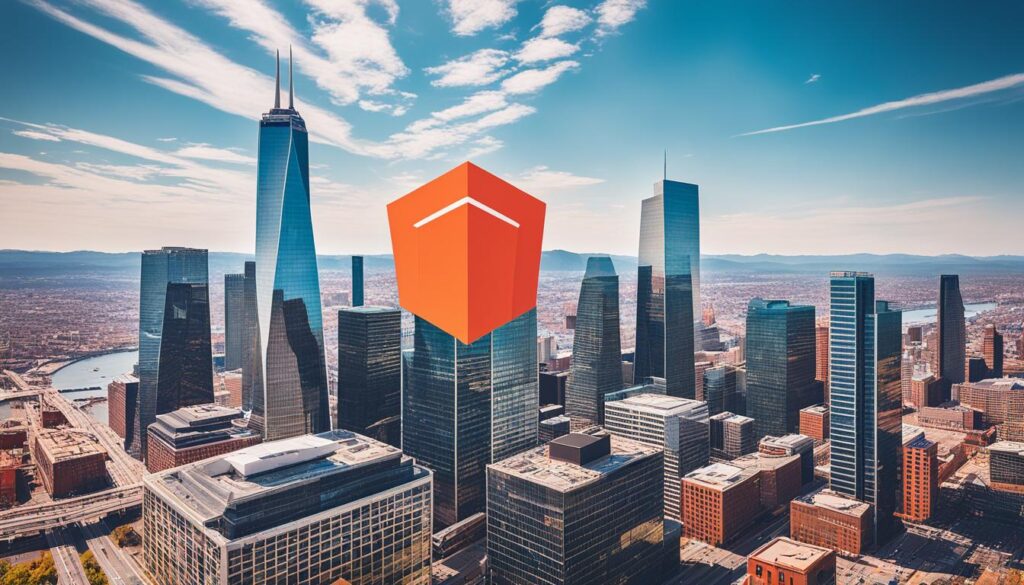Technology keeps getting better, making scalable web applications more important than ever. Companies need apps that can handle more traffic and data as they grow. Laravel, a top PHP framework, is great for making these scalable apps.
This guide will cover key tips and techniques for using Laravel to build apps that grow with your needs. You’ll learn about scalable design, caching, load balancing, and more. By the end, you’ll know how to make apps that can handle more users and data.
Table of Contents
Key Takeaways
- Understand the core features and benefits of the Laravel framework for building scalable web applications.
- Learn principles of scalable web application design and how to apply them using Laravel’s architecture.
- Discover techniques for optimizing database interactions, implementing caching strategies, and leveraging Laravel’s modular design.
- Explore strategies for load balancing, horizontal scaling, and asynchronous processing to handle increasing traffic and user demands.
- Implement best practices for security, monitoring, and logging to ensure the reliability and integrity of your Laravel-based web applications.
What is Laravel and Why Use It?
Laravel is a top PHP framework for web application development. It’s known for its strong features, easy-to-read code, and big community support. This makes it a top choice for building web apps that grow and are easy to keep up with.
Laravel’s Features and Benefits
Laravel stands out because of its many features and benefits. It has a design that lets developers use its parts to make apps that work well and can grow. It also has tools like Eloquent ORM and a command-line interface that make building apps easier and faster.
- Elegant and expressive syntax for clean, maintainable code
- Comprehensive security features to protect against common web vulnerabilities
- Seamless integration with popular third-party libraries and services
- Extensive documentation and a thriving community of developers
Laravel’s Popularity and Community Support
Laravel is getting more popular thanks to its active and helpful community. It has a big group of users who share resources, like documents and tutorials. This means developers can find many solutions for their projects, making it easier to work with.
Also, Laravel keeps getting better with new updates and ideas. It’s becoming a top PHP framework for building great web applications. Developers choose it for its power, flexibility, and ability to grow with their projects.
Principles of Scalable Web Application Design
Creating a scalable web app needs careful design. By using these principles, developers make apps that grow with traffic and keep performing well. They also stay available to users.
Modularity is a key idea in scalable design. Breaking the app into smaller parts makes it more flexible and easier to update. It lets you scale parts separately, which makes adding new features and updates smoother.
Caching is also vital. It uses techniques like in-memory caching and CDNs to make apps faster. This reduces the load on the app and database, letting them handle more users at once.
Asynchronous processing helps apps deal with tasks that take a long time without slowing down. It moves tasks like background jobs to separate processes. This keeps the app fast and always available.
Load balancing is crucial for scalable apps. It spreads traffic across servers, preventing any one server from getting overwhelmed. This makes the app grow easily as more users come on board.
Using these design principles, developers make apps that are strong, efficient, and can grow with their users. The next parts of this article will show how to apply these principles with the Laravel web framework.
Building Scalable Web Applications with Laravel
Laravel is a top PHP framework for making web apps that grow and stay safe. It’s great for developers who want to build apps that can handle more users and keep data safe. This is thanks to its design and features.
Laravel’s modular design is key to its scalability. It breaks down into parts, each handling a different task. This makes it easy to add or change parts without affecting the whole app. It also means code can be reused, tested, and works well with other services.
Using dependency injection is another way Laravel helps make apps scalable. This system helps manage how different parts of the app talk to each other. It makes the code easy to test and scale. It also supports design patterns like the Repository and Service patterns, making apps better at handling more users and changing needs.
With Laravel’s design and patterns, developers can make apps that grow and change with their business. This means the app can handle more users and keep running smoothly, without losing performance or stability.
“Laravel’s modular design and dependency injection system are key to building scalable and maintainable web applications.”
Leveraging Laravel’s Modular Architecture
Laravel is a top PHP framework known for its modular design. This design lets developers make web apps that grow and stay easy to keep up with. By using modular design, Laravel helps developers keep their code flexible and easy to use.
Separating Concerns with Laravel
Laravel’s core idea is to separate different parts of an app. This means breaking an app into smaller, independent pieces. Each piece handles a specific task, making the code clear and simple to manage.
Using Laravel’s Dependency Injection
Laravel’s dependency injection system is key to its modular design. It lets developers create objects without linking them too closely. This makes changing or testing parts of the code easier. It supports the Laravel modular architecture and Laravel separation of concerns, helping build apps that grow and change easily.
“Laravel’s modular architecture and design patterns, such as separation of concerns and dependency injection, empower developers to create scalable and maintainable codebases.”
Using these ideas, developers can make apps that grow and adapt. Laravel’s dependency injection helps build apps that are ready for new needs and updates.
Optimizing Laravel’s Database Interactions
Building scalable web apps with Laravel means focusing on optimizing database interactions. Using Eloquent ORM helps developers make their database queries faster and improve their apps’ performance.
Efficient Database Querying with Eloquent ORM
Eloquent, Laravel’s ORM, makes working with the database easy. But to get the best database performance and scalable data handling, developers need to use best practices. Here are some tips:
- Eager Loading: Use Eloquent’s eager loading to cut down on database queries. The
with()method lets you load related models in one query. - Query Scopes: Query scopes help you put common database queries into one place. This makes your code easier to maintain and use again.
- Laravel database optimization: Use caching, like Laravel’s cache or Redis, to lower the number of database queries and speed up responses.
- Pagination: For big datasets, use Eloquent’s pagination to split results into smaller parts. This boosts database performance and makes things better for users.
“Optimizing database interactions is key to making scalable web apps with Laravel. By using Eloquent’s strong features, developers can greatly improve their apps’ efficiency and performance.”
Learning these methods and ideas lets developers use the Eloquent ORM to the fullest. This leads to better scalable data handling and makes their Laravel-based web apps faster and more scalable.
Implementing Caching Strategies in Laravel
Caching is key in making web apps scalable with the Laravel framework. It boosts your app’s speed and makes it more responsive. By using smart caching, you can make your Laravel apps run smoother.
Using Laravel caching cuts down on server and database load. It stores data that’s often needed, so your app doesn’t have to ask for it all the time. This makes your site faster and more user-friendly.
Laravel has many caching strategies to fit your app’s needs. You can use in-memory caching with Redis or Memcached, or the built-in file caching. Each method has its own perks, helping you fine-tune your app’s speed.
Adding Laravel caching to your projects lets you make the most out of Laravel. You can create scalable web applications that give users a great experience. Your app will be fast and responsive.
| Caching Strategy | Description | Advantages |
|---|---|---|
| Redis Caching | An in-memory data structure store, commonly used for caching | Fast, efficient, and scalable caching solution |
| Memcached Caching | A distributed memory-based caching system | Highly scalable, with support for distributed caching |
| File-based Caching | Laravel’s built-in caching system that stores cached data in files | Simple to implement, suitable for small to medium-sized applications |
“Caching is a powerful technique for improving the performance and scalability of your Laravel-powered web applications. By carefully implementing the right caching strategies, you can significantly enhance the user experience and reduce the load on your infrastructure.”
Load Balancing and Horizontal Scaling
As web applications grow, managing traffic and ensuring they’re always available becomes key. Laravel, a popular PHP framework, has strong solutions for these issues. It uses load balancing and horizontal scaling.
Using Laravel with Load Balancers
Load balancing spreads incoming traffic across several servers. This makes web applications run better and more reliably. With Laravel, developers use load balancers to spread the workload evenly. This prevents any one server from getting too busy and keeps the app always available.
Load balancers send requests to the best server based on things like server load or location. This helps Laravel apps handle lots of traffic smoothly. It keeps the user experience good, even when many people are using the app at once.
Scaling Laravel Applications with Multiple Servers
To deal with more users and traffic, Laravel apps can be scaled by adding more servers. This is called horizontal scaling. It spreads the work across more systems, making the app faster and more reliable.
Laravel’s design and support for cloud deployment make scaling easy. Developers can quickly add more servers. This keeps the app fast and always available, even with more users or complex tasks.
| Technique | Description | Benefits |
|---|---|---|
| Laravel Load Balancing | Distributing incoming traffic across multiple servers to improve performance and availability. | Increased scalability, redundancy, and high availability for Laravel applications. |
| Horizontal Scaling | Adding more server instances to accommodate growing user demands and traffic. | Improved overall performance, responsiveness, and the ability to handle sudden spikes in user activity. |
Using load balancing and horizontal scaling, Laravel developers can make apps handle lots of traffic and ensure a smooth user experience. This is true even as the app gets more complex and has more users.
Asynchronous Processing with Laravel
In today’s fast-paced web development, handling tasks that take a long time can be tough. Laravel, a popular PHP framework, has a great solution. It uses a queue system to move these tasks to the background. This makes the main application faster and more scalable.
Leveraging Laravel’s Queue System
Laravel’s queue system lets developers run tasks that take a long time without slowing down the main app. These tasks are put in a queue and run in the background. This makes the app more responsive and improves its performance.
This system is very flexible. Developers can pick from different queue drivers like Redis, Amazon SQS, or database-based queues. This lets them fit the queue system into their apps easily, making sure it works well.
With Laravel’s queue system, developers can offload many tasks. These include:
- Sending email notifications
- Processing large data sets
- Generating reports or analytics
- Integrating with third-party services
By moving these tasks to the background, developers can focus on the main parts of their app. They know their app will still perform well and scale as needed.
| Feature | Benefit |
|---|---|
| Laravel Queues | Offload resource-intensive tasks to a background process, improving application responsiveness and scalability |
| Customizable Queue Drivers | Choose from a variety of queue drivers, such as Redis, Amazon SQS, or database-based queues, to fit your application’s needs |
| Asynchronous Task Processing | Ensure that the main application remains responsive while long-running tasks are processed in the background |
Using Laravel’s queue system, developers can make web apps that work great even with complex tasks. This approach to handling tasks in the background is key for any developer wanting to improve their Laravel apps’ performance and scalability.
Monitoring and Logging in Laravel
Monitoring and logging are key for keeping web applications running smoothly. As your Laravel app grows, it’s vital to understand how it performs and stays healthy. Luckily, Laravel has strong tools for monitoring and logging to keep you informed about your app’s behavior.
Leveraging Laravel’s Logging Features
Laravel’s logging system is a powerful tool for tracking your app’s actions. It comes with drivers like daily, syslog, and error_log. You can set up these drivers to log errors, warnings, and more, helping you understand your app’s performance and scalability.
- Customize log levels to capture only the most critical information or dive deeper into granular details.
- Integrate third-party logging services, such as Papertrail or Logstash, to centralize and analyze your logs.
- Use Laravel’s built-in logging facade to record custom log entries and track specific application events.
Monitoring Laravel Applications
Logging is great for seeing what’s happening in your app, but Laravel monitoring tools give you a broader view of performance. These tools help spot bottlenecks, track resource use, and fix issues before they affect users.
| Tool | Description | Key Features |
|---|---|---|
| New Relic | A comprehensive application performance monitoring (APM) solution |
|
| Blackfire | A profiling tool that provides insights into your application’s performance |
|
| Horizon | A powerful tool for managing and monitoring Laravel’s queuing system |
|
Using these monitoring tools gives you deep insights into your Laravel application’s performance and scalability. This lets you tackle issues early and make your system better for users.
Security Best Practices for Laravel Apps
Web applications are getting bigger and more complex, making security crucial. Laravel, a popular PHP framework, has many security features. These can help developers make secure and scalable web applications. We’ll look at some top ways to boost Laravel security and protect your web application security.
Leveraging Laravel’s Built-in Security Features
Laravel is known for its focus on security. It has many security features built-in. These can protect your app from common threats like XSS, CSRF, and SQL injection.
- Authentication: Laravel’s system makes logging in, signing up, and resetting passwords secure. It helps manage who can access your app.
- Authorization: This system lets you set who can do what in your app. It makes sure only the right users can access certain parts.
- Input Validation: Laravel’s input validation stops bad data from getting into your app. This prevents issues like code injection.
Using these security best practices in your Laravel app makes it much safer. This helps keep your scalable web applications secure.
“Secure your Laravel application at the foundation to ensure your users’ data and your business are protected.”
Building Scalable Web Applications with Laravel: Tips and Techniques
Creating web applications that can grow with your needs is key in today’s tech world. Laravel, a top PHP framework, has many features and best practices for this. We’ll look at the main tips and techniques for making Laravel apps that handle lots of traffic and stay fast.
One important strategy is to use Laravel’s modular design. This means breaking your code into smaller parts. It makes your app easier to maintain, scale, and test. Also, using Laravel’s dependency injection system makes your app parts more flexible and reusable.
Improving how your app talks to the database is key for scalability. The Eloquent ORM and smart database queries can lessen the load on your app. This is especially true when your app gets a lot of traffic.
Caching is a big help for making Laravel apps scalable. With caching, like in-memory caching with Redis or Laravel’s own system, your app uses fewer resources. This means faster times for your users.
Load balancing and scaling your app horizontally are also vital. By spreading your app’s work over several servers and using load balancers, you can handle more traffic. This keeps your app available to everyone.
Using Laravel’s queue system for tasks like sending emails or background jobs can also help. It moves these tasks away from the main app. This makes your app faster and more scalable.
With these tips, you can make Laravel apps that handle lots of traffic, are fast and reliable, and grow with your users’ needs.
Automated Testing for Scalable Laravel Apps
Building scalable web applications needs a strong and dependable codebase. Automated testing is key for this, making sure Laravel projects stay stable and scalable. With thorough unit, integration, and end-to-end testing, developers can build scalable web applications that handle more users and changes well.
Unit Testing with Laravel
Unit testing is vital for a solid Laravel app. It lets developers check if each part of the app works alone, making sure everything functions correctly. Laravel’s PHPUnit framework makes writing and running these tests simple, helping catch problems early.
Integration and End-to-End Testing
Unit tests are important, but they only look at parts of the app. Integration tests and end-to-end tests check how all parts work together. They mimic real user actions, making sure the app works smoothly from start to end.
Using a strong automated testing plan with Laravel builds confidence in the code. It lowers the chance of bugs and makes sure scalable web applications keep working well as they grow.
Deploying and Maintaining Laravel Applications
As developers, we know how key it is to make sure our Laravel apps are scalable, reliable, and easy to maintain. Deploying and keeping these apps running well needs a good plan. We’ll look at the best ways to do this.
Deployment Strategies for Laravel Apps
Deploying a Laravel app can be tricky, but the right strategies make it smoother. Here are some top ways to deploy Laravel apps:
- Continuous Integration and Deployment: Automating the build, test, and deploy process cuts down on errors and makes sure deployments are consistent and reliable.
- Blue-Green Deployment: This method keeps two identical production setups. You can switch between them easily, causing little to no downtime.
- Canary Deployment: This strategy updates a small part of your users or servers first. This lets you see how it goes and roll back if needed before full deployment.
It’s important to have a clear, documented process for deploying your app, no matter the strategy you pick.
Ongoing Maintenance and Monitoring
Looking after a Laravel app doesn’t stop after you put it out there. Keeping an eye on it and doing proactive maintenance is key for its long-term success. Important parts of ongoing upkeep include:
- Regular security updates and patches to fix vulnerabilities
- Improving performance with caching and database tweaks to keep it fast
- Monitoring and logging to spot and fix problems quickly
- Automated testing to find bugs and make sure the app works right
With a solid maintenance plan, your Laravel app will stay in top shape, even as it grows and changes.
In summary, deploying and keeping a Laravel app running well takes careful planning. Using the right deployment methods and strong maintenance steps helps your app stay reliable, fast, and ready for whatever comes next.
Performance Optimization Techniques
For startups, making a web application fast and able to grow is key. The Laravel PHP framework has many ways to make this happen. By using these methods, startups can make their Laravel performance optimization better. They can also make their web application performance better and handle lots of high traffic.
One big way to make Laravel faster is by using caching. Laravel has options like file-based caching, Redis, and Memcached. These can cut down the load on the database and make the app respond quicker. Also, the framework’s Eloquent ORM helps write efficient queries and use indexing for faster data access.
Another key area is optimizing assets like CSS, JavaScript, and images. Laravel’s Asset Pipeline makes it easy to manage and speed up these files. Features like minification, versioning, and compression can make pages load faster and improve user experience.
| Optimization Technique | Description | Benefits |
|---|---|---|
| Caching | Leveraging Laravel’s caching capabilities to reduce database and server load | Faster response times, improved scalability, and reduced infrastructure costs |
| Database Optimization | Optimizing database queries and leveraging Eloquent ORM features | Improved data retrieval performance, reduced database load, and enhanced scalability |
| Asset Optimization | Optimizing CSS, JavaScript, and image assets through minification, versioning, and compression | Faster page load times, improved user experience, and reduced bandwidth usage |
By using these Laravel performance optimization methods, startups can make their web apps scalable, fast, and ready for high traffic. The mix of Laravel’s strong features and these strategies can really help startups build successful web solutions.
Conclusion
In this article, we’ve looked at Laravel, a top PHP framework, and its great potential for making web applications scalable. We covered what makes Laravel stand out and how to use its design principles for scalable projects.
We talked about Laravel’s modular setup, how it works with databases, caching, and handling tasks at the same time. These are key to making web apps fast and scalable. We also touched on important topics like security, keeping an eye on performance, and how to deploy projects well.
Starting your own Laravel scalable web applications project? Use what you learned here. With Laravel’s tools and ways of working, you can make strong, growing web apps. These apps will keep up with what your users and customers need. The key takeaways from this article will help you use Laravel scalable web applications to their fullest.














